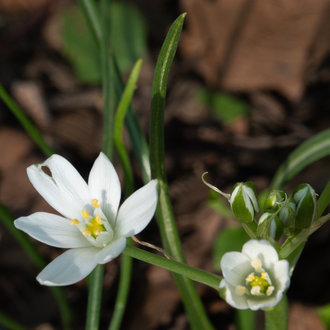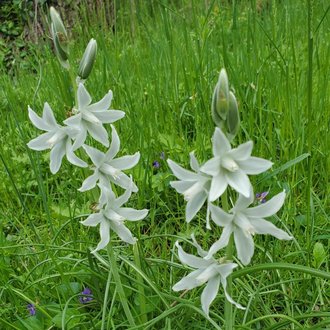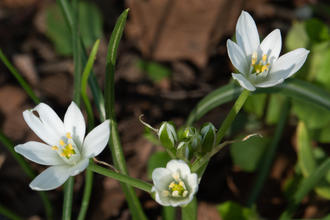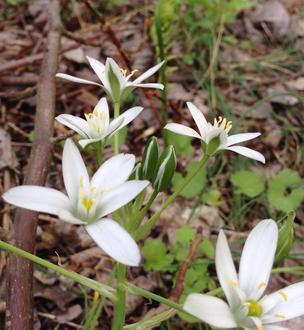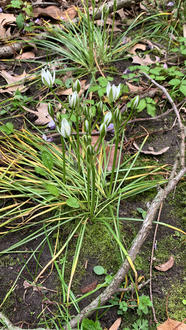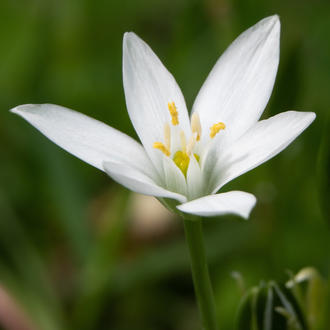Common Star of Bethlehem (Ornithogalum umbellatum L.)
↑Summary
A perennial native to Europe and widely planted in gardens; established in the wild across North America and widely considered to have invasive potential.
↑Description & Identification
A bulbous perennial, initially forming a clump of grasslike foliage, long, narrow (2-6mm) leaves with a white stripe. Bulbs of mature plants usually about an inch in diameter, often surrounded by small bulblets. Six-petaled white flowers usually arranged in a flat-topped cluster, open upward. Plants usually reach about 1 foot in height. Foliage often flops over by the time the plant blooms. Foliage dies down quickly after setting seed, and plants often not easily detectable above ground when dormant.
↑Similar Plants
↑Habitat
As this plant is in the early stages of establishing in the wild in North America, its potential habitat preferences are not well-known.
Currently it is most frequent in and around gardens where it has been intentionally planted, and it also can establish and reproduce in lawns. Also found in meadows, fields, forest edges, waste ground, streambanks, and drainage ditches. Generally favors moist to mesic, disturbed habitats in full sun to light shade, and fertile loamy soil. Due to its dormancy later in the growing season, moisure and sun are only required in spring to early summer; this plant can be found in areas where the soil is drier and/or shade is heavier at other times of year.
This plant probably has some potential to invade intact natural habitats and displace native spring ephemerals, but the full extent of its invasive potential is not known.
It is most widely-established from Missouri east through the Mid-Atlantic and into southern New England, but scattered populations have established as far as Texas, Nebraska, Alabama, South Carolina, Minnesota, and Maine, as well as separate populations in Utah and in the Pacific Northwest, including both coastally and farther inland. This plant seems able to establish in the wild under a wide range of climate conditions.
↑Life Cycle
Common Star of Bethlehem is a bulbous perennial, and a spring ephemeral.
Plants newly sprouted from seed may take as much as three years or often longer before they bloom.
Vegetation emerges early in spring and plants flower from April to May. Seeds ripen June to July, after which most of the plant dies down and goes dormant until the following spring. Plants are self-fertile.
We were unable to find information on the timing of germination in the wild, or whether or not this species persists long-term in the seed bank. However, gardening sites suggest that the seed usually germinates in spring after a period of cold dormancy.
Plants also reproduce vegetatively, by division of bulbs, which initially results in bulblets (small plants) adjacent to the parent plant. Over time this can create large clusters or colonies of the plant. Soil disturbance or transport of soil containing these bulblets can result in vegetative spread to new areas.
↑Faunal Associations
In North America, this species has low value to wildlife. It is rarely eaten by any insects. It is toxic to mammalian herbivores and as such avoided by them. Although it is insect-pollinated, its flowers are not attractive to most native pollinators and are often self-pollinated. The flowers are sometimes visited by honeybees.
Because this species competes with other spring ephemerals with greater wildlife value, it tends to have negative effects on wildlife. It even has low value relative to other non-native lawn weeds.
↑Control
Control of this plant is difficult and labor-intensive, and has a narrow time-window in which it can be carried out. As with most plants that have not yet established in most of North America, the most important aspect of control is prevention: avoiding planting this plant in your garden and avoiding selling it, and encouraging businesses not to sell it.
Herbicides are usually ineffective at controlling this plant. As a monocot, most selective herbicides that target broadleaf weeds do not affect it or only minimally effect it. The leaves also have a waxy coating that reduces absorption of herbicides. Furthermore, division of bulbs can result in some dormant bulblets persisting even in the case that the parent bulb is killed. Plants often resprout in subsequent years even if herbicide stunts their growth through one growing season. Care must be taken not to spread bulbs or bulblets to new areas.
Hoeing and tilling is not only ineffective at controlling this plant, it often can result in its spread by distributing bulblets. It is important to avoid excessive soil disturbance in areas where this plant occurs, and to avoid transporting any soil from any infested areas.
Digging up the bulbs, which are relatively large and usually easy to find in the loamy soil that this plant tends to grow in, is usually the most effective way to control this plant. The best time to dig bulbs is usually as soon after their emergence as you notice them; waiting longer can result in increased energy flowing back to bulbs, and division of bulbs into small bulblets which are harder to remove. It is also important to identify all plants (by foliage), not just flowering plants, as young plants formed by seed or division will send up foliage but usually will not bloom. Follow-up is usually necessary to remove missed bulbs in subsequent years.
In cases where it is not practical to dig all bulbs, seed production can be prevented by cutting or mowing the plants during or immediately after it flowers, before it produces seed. This will prevent seed production for the one year and can reduce the plant's spread. Plants can also be stressed or reduced if their foliage is cut to the ground shortly after its main growth spurt. However, typical mowing does not harm this plant enough to kill it, as its foliage is often partly or mostly pressed agaist the ground where it escapes the blades of most mowers. For such cutting, the foliage must be carefully gathered by hand and cut to the base.
Supporting competing native vegetation can also reduce this plant's spread as well as preventing its establishment by seed in new areas.
↑Uses
For years this plant was widely planted in gardens, but its use is waning due to its now-recognized invasive potential. It was previously valued for its flowers and attractive foliage, and ease of growing.
The plant also has a number of historical medicinal uses. It contains cardiac glycosides which has led it to be used traditionally for the treatment of congestive heart failure. However, because these compounds can have potent activity on the heart and other systems, its use is not considered safe.
↑Related Plants
This plant is the most widely-distributed Ornithogalum species in North America. Three others, however, are also established in the wild, all introduced. The next most common is drooping star of bethlehem (Ornithogalum nutans) is established in the wild on scattered sites throughout the northeast and northwest. False seaonion (Ornithogalum caudatum) is established at several sites in Arkansas, and pyrenees star of bethlehem (Ornithogalum pyrenaicum) is established only in a small region of West Virginia.
↑Links & External Resources
• Ornithogalum umbellatum (Star-of-Bethlehem) | Illinois Wildflowers (About This Site)
• Ornithogalum umbellatum (star of Bethlehem) | USDA PLANTS Database (About This Site)
• Ornithogalum umbellatum | Go Botany (About This Site)
• Common Star-of-Bethlehem | iNaturalist (About This Site)
• Ornithogalum umbellatum (Star of Bethlehem) | Missouri Botanical Garden Plant Finder (About This Site)
• Ornithogalum umbellatum | Biota of North America Project (BONAP) (About This Site)
• Ornithogalum umbellatum | NatureServe Explorer (About This Site)
• Ornithogalum umbellatum | Flora of North America (About This Site)
• Ornithogalum umbellatum | Missouri Plants (About This Site)
• Star of Bethlehem | Maryland Biodiversity Project (About This Site)
• Ornithogalum umbellatum L. (Common Star-of-Bethlehem) | Digital Atlas of the Virginia Flora (About This Site)



